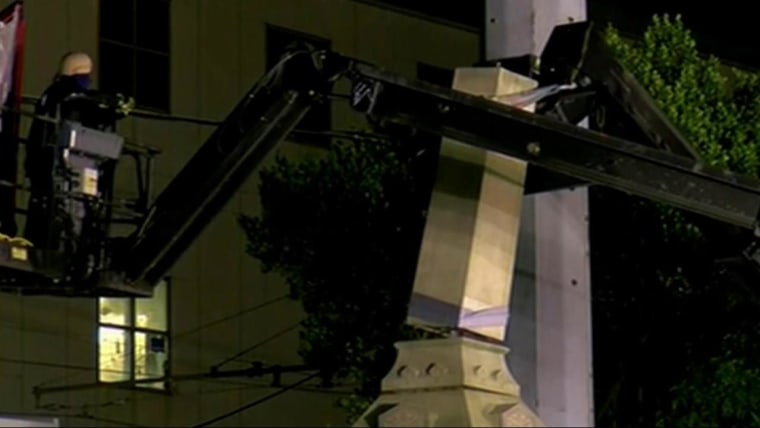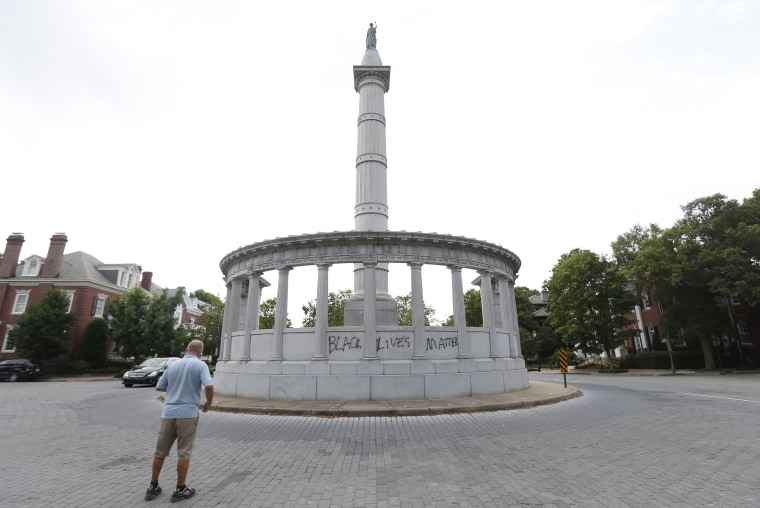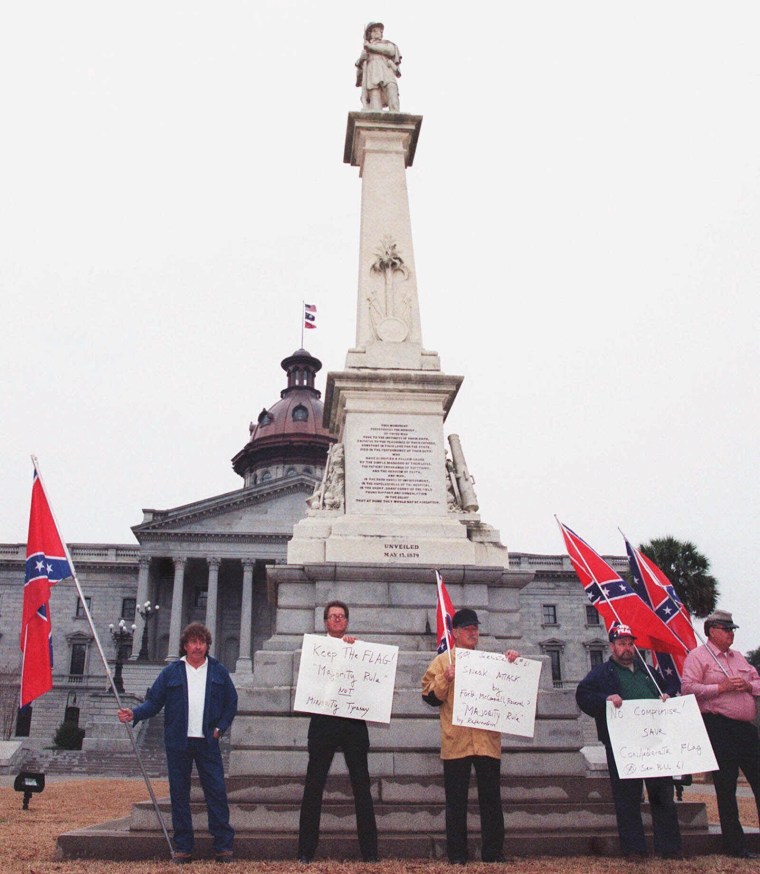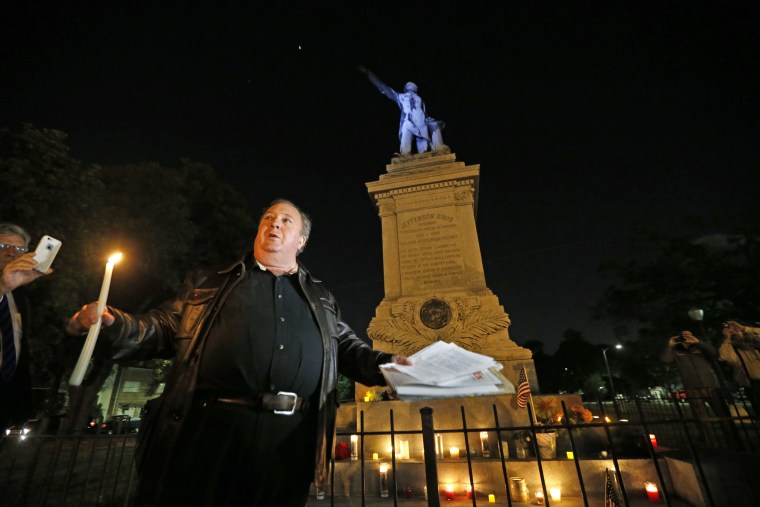what has led to the removal of civil war statues
Almost two years after New Orleans mayor Mitch Landrieu chosen for the removal of four Amalgamated statues from public spaces around the metropolis, the process finally got underway soon after 1 a.m. Mon morning.
The Liberty Monument, which paid tribute to vigilantes who sought to overthrow the city's interracial Reconstruction era authorities, was the outset to go — and in the coming days and weeks, the 3 remaining Confederate statues honoring Generals Robert E. Lee, P.G.T. Beauregard and Confederate President Jefferson Davis volition also be removed.

Like debates well-nigh the appropriateness of honoring Amalgamated legends with memorials, eponymous roads, streets and buildings are taking place nationwide.
This effect resurfaced, in large measure, following the June 2015 murder of 9 African Americans parishioners by white supremacist Dylann Roof in Charleston. South Carolina removed the Confederate flag from its statehouse grounds in the wake of the massacre.
Several other Southern cities have taken like measures and/or began debating the removal of their Civil War monuments. In Richmond, Virginia residents have long chosen for the Monument Avenue to be cleared gratis of Confederate statues, just without success. Statues of Jefferson Davis and Robert East. Lee have been vandalized numerous, the latest during anti-Trump protests later the election.
Before this year, the Charlottesville, Virginia Metropolis quango voted 3-2 to take away the statue of Robert Eastward. Lee and rename Lee Park.

Alfred Fifty. Brophy, the Judge John J. Parker distinguished professor of law at UNC Chapel Hill, warns against the rush to rid the country of these tactile reminders of Jim Crow and the codification of white supremacy.
"My initial thought is that removing these monuments leads to forgetting," says Brophy. "We need to be aware that people in power at that time thought it was appropriate to celebrate slavery and Jim Crow."
Brophy believes that making these artifacts disappear allows certain people to rewrite history, whereas, keeping them in place stands as a salient reminder of the times.
Kirk von Daacke, Associate Professor and Assistant Dean Department of History at the Academy of Virginia, agrees that, as a club, nosotros benefit from learning near our own past in all its complexity. Still, he believes that removing Confederate statues and memorials, often erected several decades later on the Ceremonious War is a way to reject a history of Lost Cause glorification of the Confederate cause and the history of muscular white supremacy that went hand in hand with the Lost Cause.

Related: Harriet Tubman National Historical Park Becomes Reality
He as well points out that many of these memorials lack context and are inscribed to glorify or deny the brutality of that flow. "Rethinking the memorial mural—whether that involves moving memorials, adding new memorials, and/or reshaping how the memorials are viewed—is a necessary footstep in creating a more inclusive history and more inclusive public spaces," said von Daacke.
The Historical Marker Database lists more than 13,000 monuments and memorials beyond the county still information technology's hard to know precisely how many of these pay tribute to Confederates. What is non in dispute, notwithstanding, is that commemorations to the Secessionist cause tin be institute in every former Amalgamated state.
The overwhelming majority were installed following the collapse of Reconstruction and during the ascension of the Jim Crow era. But non all fall into these categories. Arizona wasn't even a state, let solitary part of the Confederacy, during the Civil War. Yet, information technology boasts iii Amalgamated statues, the concluding of which was erected in 2010. Getting rid of them is more than a notion.

Afterward the New Orleans Urban center Council voted overwhelmingly to remove the city'due south Confederate statues, the City spent nearly 18 months embroiled in costly litigation brought past three historical societies and the Sons of Confederate Veterans.
The planned removal—estimated to cost $600,000—only moved frontwards after the 5th Circuit affirmed a lower court ruling and rejected their claims as defective "legal viability or support." Charlottesville'due south government-approved removal carries a price tag of $400,000 and is also mired in a courtroom battle with the Sons of Confederate Veterans.
Related: Georgetown Apologizes, Renames Halls Later on Slaves
4 states have fabricated it impossible to remove or alter their historic structures, regardless of the desires of local municipalities. Afterwards a protracted fight to have down the Confederate flag from the state's Capitol dome in 2000, South Carolina passed the Heritage Protection Act to prohibit the removal of Confederate monuments from public property. Georgia, Mississippi and Tennessee quickly followed suit.
If and when these structures are removed, what will get of them?
Charlottesville elected to sell and relocate its Confederate relics. Mayor Landrieu said that the New Orleans statutes volition be stored and preserved until they can be displayed in a more appropriate identify.
"Nosotros can remember these divisive chapters in our history in a museum or other facility where they can be put in context — and that'south where these statues vest," he said.
Follow NBCBLK on Facebook, Twitter and Instagram
morganroublet1998.blogspot.com
Source: https://www.nbcnews.com/news/nbcblk/are-removing-confederate-monuments-erasing-history-n750526
0 Response to "what has led to the removal of civil war statues"
Postar um comentário